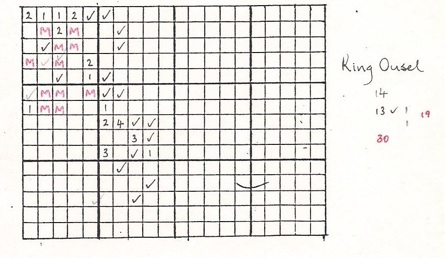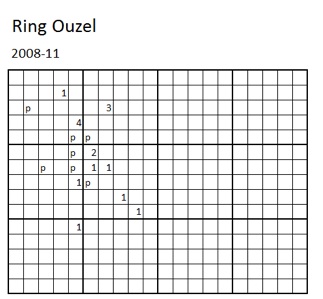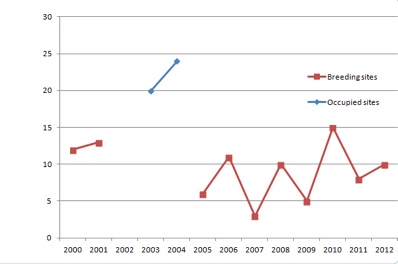Birds Near and Far
Home books dvds apps sites extra maps links contact us blog Buy
Birds Near and Far
Home books dvds apps sites extra maps links contact us blog Buy
A blog by Dave Gosney about some of the birds and places that feature in his books and DVDs but also about the state of birds in the Sheffield area



p = present but not counted during the ‘chosen’ 1-hour count (see interpretation)
It looks here as though there were far fewer Ring Ouzels in the more recent survey but bear in mind that much more time was spent in the tetrads in 1988-90 (in addition to the 1-hour periods that the counts are based on).
Even so, the evidence here suggests that Ring Ouzels could be faring just as badly in the Peak District as elsewhere. However, this is a species which, due to its remote location and elusive nature, could give misleading results based on just one 1-hour visit to each area. Thankfully we have other data too; what tale does that tell?
Occupied tetrads
In The Breeding Birds of the Sheffield Area, Wood and Hill analyse the number of occupied tetrads in 2003-08 compared with 1975-80 and point out that 'if 'possible' breeding is disregarded, the combined figures for [confirmed and probable breeding] remain almost identical. The actual figures are 50 occupied tetrads in the late 70's and 51 in the 00's; that's NO DECLINE AT ALL over a period of about 30 years.
Given the declines elsewhere, that seems astonishing. But their survey began in 2003; if the decline has happened since then, it might not have been picked up in their comparison. What do we know about what has happened since 2003?
Evidence from bird reports
The admirably complete data in the annual Sheffield Bird reports might help us to answer that question. Here's a graph showing the annual numbers of Ring Ouzel sites in which breeding was confirmed (in red) or probable (in blue).

Obviously, numbers fluctuate from year to year, possibly in relation to observer effort but there is nothing here to suggest there has been a local decline.
So maybe it's true that the Peak District is one part of the UK where Ring Ouzels are still doing OK. If that's the case (and it would need a more thorough survey to confirm it) then maybe we need to study what is different about the Peak District environment compared to other moorland areas.
5th February 2015
Is the Peak District the last bastion for the UK’s Ring Ouzels?
In my recently published paper in British Birds, Ring Ouzel doesn't appear in my table showing species that have declined by 33% or more in the period 1988-90 to 2008-11. This has prompted James Anderson of the Ring Ouzel Study Group to ask me for more details, since this appears to be out of step with what he calls ‘a marked and significant decline' in other parts of the UK. Is the Ring Ouzel hanging on better in the Peak District than elsewhere in Britain?
Well, in terms of my own results, the truth is that the Ring Ouzel only just failed to make the cut in my table of declining species. In fact the number of Ring Ouzels counted in the two surveys fell by 30% (from 23 to 16). This is pretty close to the figure generated by a UK-wide survey which showed, overall, a 29% decline between 1999 and 2012 (Wooton, Stanbury and Eaton, in press) though this covers a much shorter period than my survey.
For interest, here are the two maps showing the individual tetrad counts made in 1988-90 and 2008-11.
Numbers of Ring Ouzels counted in 1-hour TTVs (see here for interpretation)
1988-90